Last updated on February 13, 2024
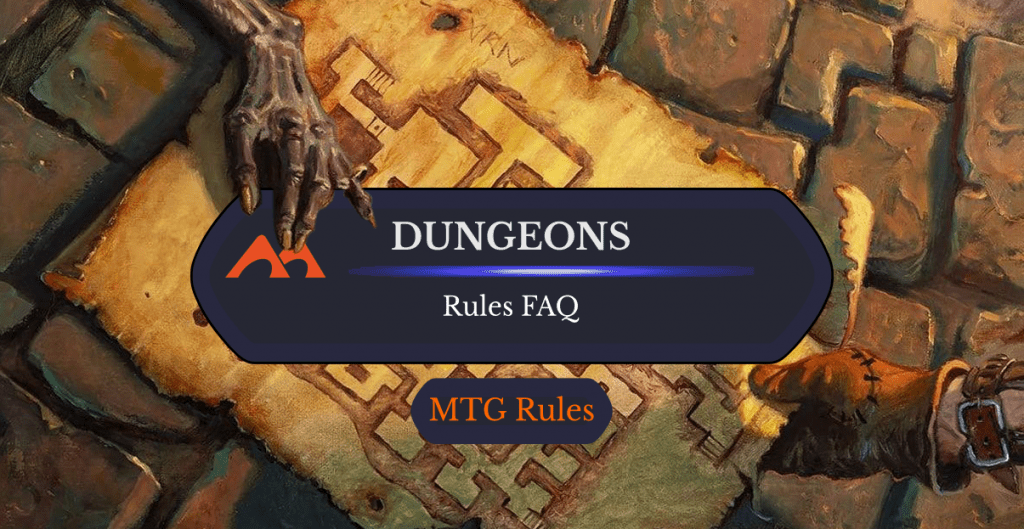
Dungeon Map | Illustration by Aaron Miller
I’m still a giant D&D nerd. That hasn’t changed since the last time I covered something related to Forgotten Realms. If anything it’s only grown as I recently ran a particularly intense session for one of my campaigns. That’s completely besides the point, though.
Dungeons in MTG! They’ve always been a thing in D&D. It’s right in the name: Dungeons and Dragons. But now they’re in Magic, too. Which is a very interesting development that I’m actually really excited about.
But what do dungeons actually do? How do they work, how do you use them, and how do you survive them? All of these questions and more will I answer here today. Ready? I hope so, ‘cause I already pushed us both into the creepy hole in the ground.
Let’s go!
What is a Dungeon in MTG?
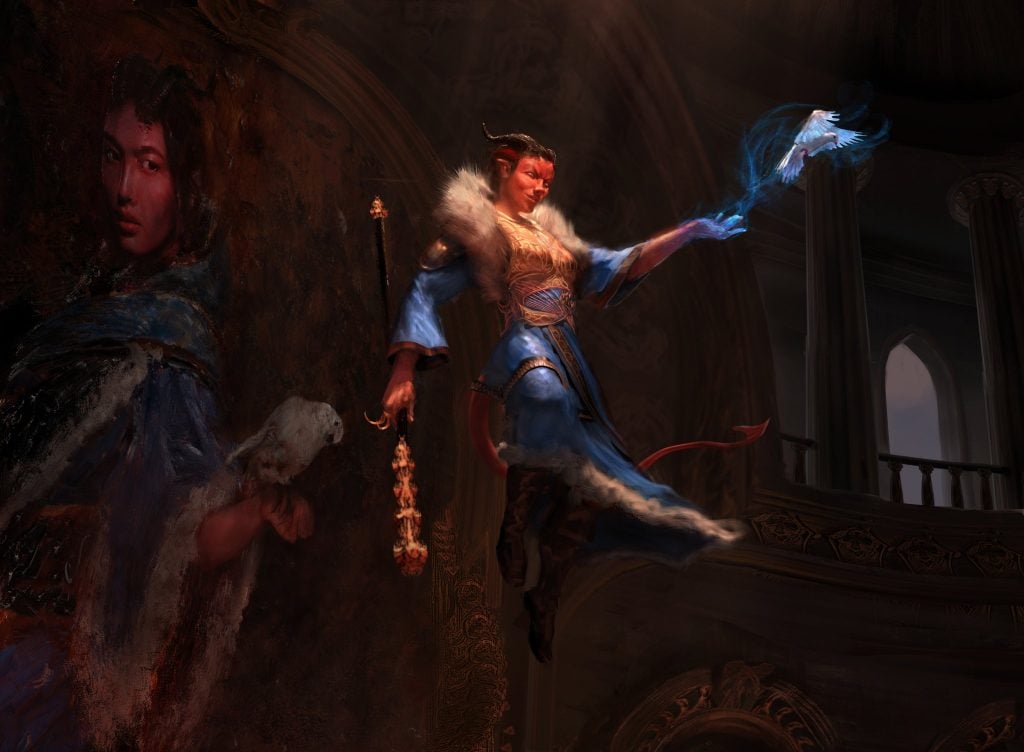
Eccentric Apprentice | Illustration by Campbell White
Dungeon is a new card type, introduced in the Adventures in the Forgotten Realms set, that allow you to “venture” down a series of rooms printed on the card to get a number of value-granting effects.
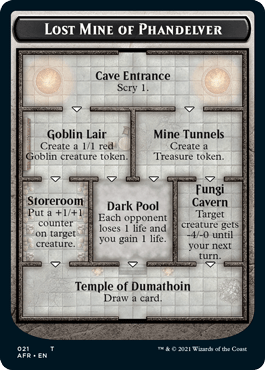
They’re very cool and flavorful and introduce an entirely new keyword action to go along with the new card type and make it all work. They’re pretty unique (that’s an understatement), so I’ll try to break them down as simply as I possibly can.
The Basics
Dungeon cards exist outside of the game; you don’t put them in your deck or sideboard. A dungeon card that’s in play exists in the command zone and leaves the game again as soon as you complete it. You can only have one dungeon in your command zone at a time. Think of it like there only being one “dungeon slot” in your command zone. If you’ve got one in there, there’s just no room for a second dungeon.
Dungeons are not considered permanents, even when they’re in play. They also can’t be cast.
The “venture into the dungeon” keyword action is how you actually move through the dungeons. Once a dungeon is in play, you move through its rooms one at a time following the arrow path that connects the rooms. A venture marker indicates which room of the dungeon you’re currently in, and you move it as you move through the dungeon.
And in case you were thinking of getting cute with this new card type and keyword, you can’t bring dungeons into the game with anything other than venture. The Raven's Warning’s final phase won’t give you a free dungeon card, sorry to report. It’ll just bounce if you try.
The Rooms
Each room in the dungeons has an ability that triggers when you enter it. These are called “room abilities.” They can only be triggered as long as the dungeon is in play in the command zone and are controlled by the player that owns the dungeon.
There’s some fun flavor in the dungeons with each room having a unique name. These don’t affect the game in any way, they’re just pure flavor text for the D&D nerds out there.
How Does Venture Into the Dungeon Work?
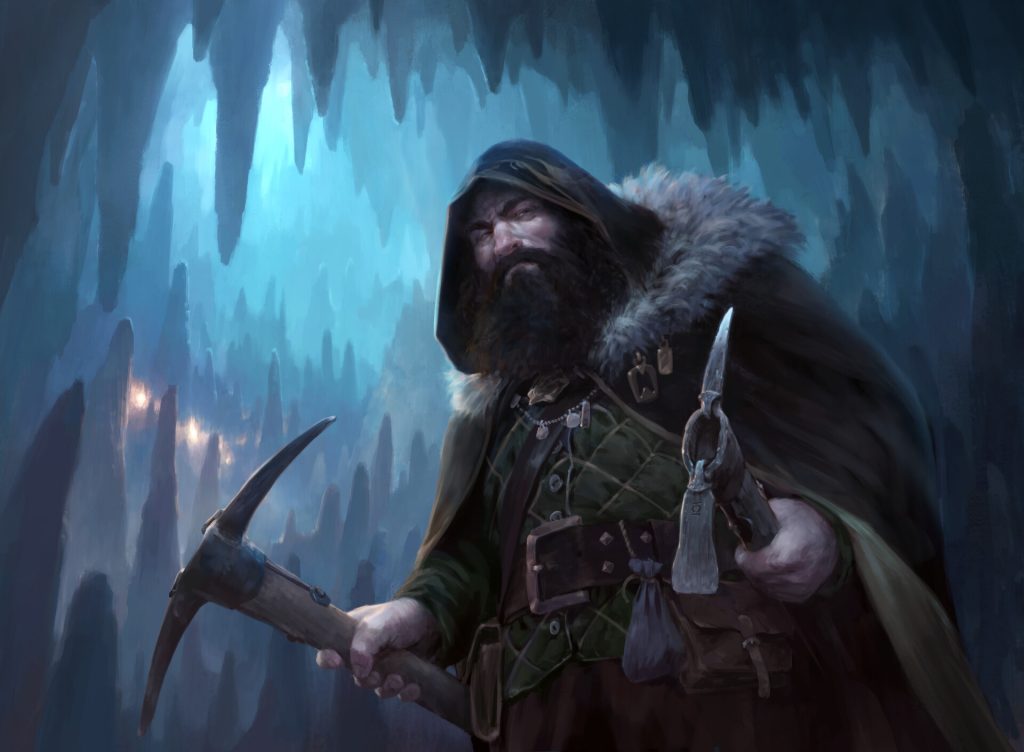
Gloom Stalker | Illustration by Tomas Duchek
Anytime you play a card that says “venture into the dungeon,” you’ll do one of two things:
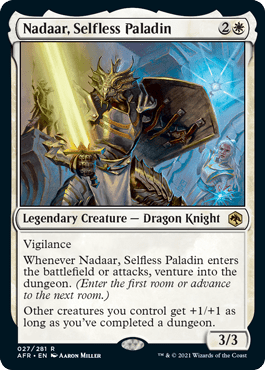
If you’re not currently in a dungeon (i.e., there’s no dungeon in your command zone), you pick which of the three dungeons you want to venture into. The chosen dungeon goes into the command zone with a venture marker on the first room and that room’s ability triggers.
If you are currently in a dungeon (i.e., there is a dungeon in your command zone), you instead move one step forward within the dungeon. This is where you’ll need to pay attention to the little white arrows:
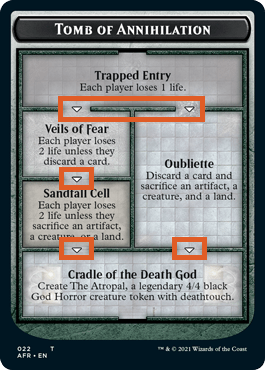
Let’s say you’re currently in the Trapped Entry room of Tomb of Annihilation. There are two arrows that point down from that room; one goes into Veils of Fear and the other goes into Oubliette. You get to pick which of the two rooms you’d like to move into the next time you venture into the dungeon. Once you do, you move your venture marker to that room and its ability triggers.
Keeping with our example, pretend you decided you were impatient and moved from Trapped Entry to Oubliette. There’s only one arrow pointing down from here, so moving to the next room when you venture into the dungeon is easy! You head into Cradle of the Death God (don’t forget your venture marker!) and its ability triggers, creating a beautiful The Atropal for you to cherish and destroy your opponent with.
Oh, and look at that! You finished the dungeon’s last room, which means you just completed Tomb of Annihilation. Congratulations! That’s pretty impressive, actually. At this point, you’ll remove the dungeon from the game and consider your payoffs officially paying off.
Can You Repeat Dungeons?
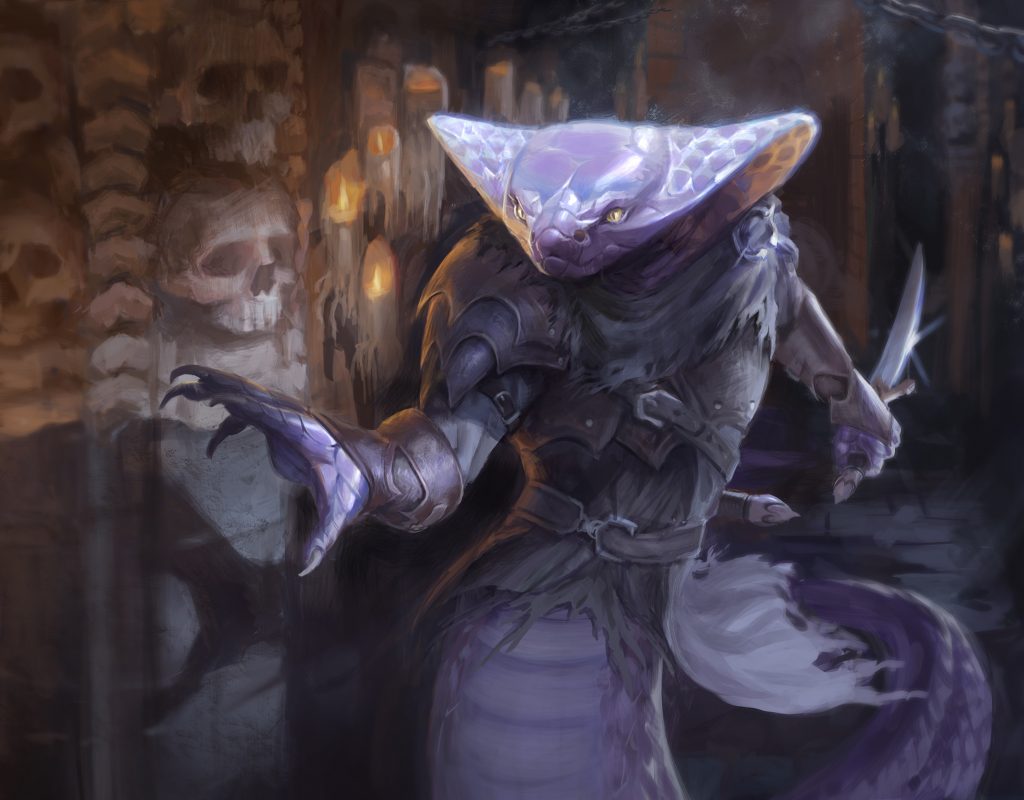
Yuan-Ti Malison | Illustration by Oriana Menendez
Yes, you can absolutely repeat dungeons! Anytime you venture into the dungeon you can choose any of the three dungeons to venture into, even if you’ve already completed it. If you pick a dungeon that you’ve already completed, you’ll just start in the first room same as when you first started it.
Want to risk the Oubliette to get another Atropal to threaten your opponent? Go for it. What about wading through the Dark Pool a second time for some tokens and an extra card? You should totally do it. If getting to the Mad Wizard’s Lair for another free spell is more your style, then that’s an option, too!
Are Dungeon Cards Legal in Commander?
Dungeon cards are legal in Commander, in a sense. You don’t put them into your deck as you do with normal cards, but the venture mechanic works just like it would in another format. As long as cards with “venture into the dungeon” are legal in Commander, dungeon cards will also be legal by proxy.
Do Dungeons Work Differently in Commander?
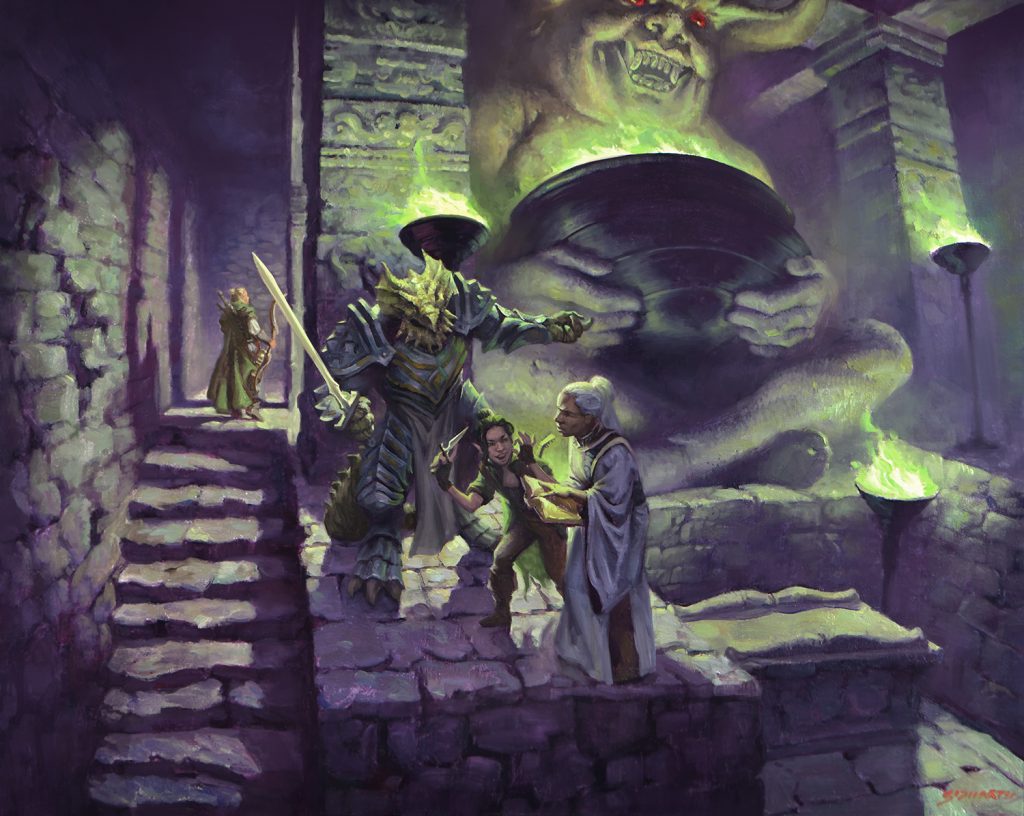
You Find a Cursed Idol | Illustration by Sidharth Chaturvedi
No, dungeons don’t work different in Commander. Like I mentioned, you venture into the dungeon just like you do in any other format. The payoff cards also work normally as long as you’ve completed a dungeon. Nothing special here.
How to Venture Into the Undercity
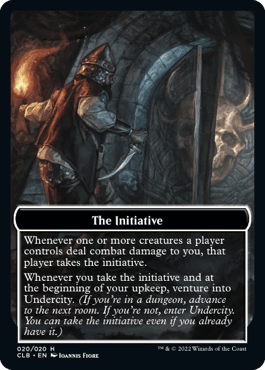

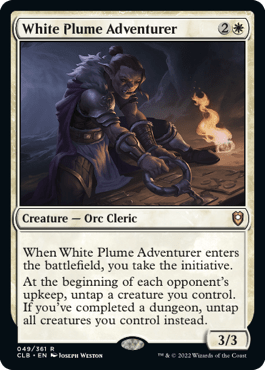
Venturing into the Undercity requires the player to have the initiative, and not currently be in another dungeon. The initiative is a mechanic similar to monarch, which can be gained through playing a card that takes the initiative or dealing combat damage to the player currently holding the initiative. Having the initiative means you'll automatically venture into the Undercity on your upkeep.
The dungeon, as well as the initiative mechanic, was introduced in Commander Legends: Battle for Baldur's Gate. Cards such as White Plume Adventurer help start the process, as no player begins the game with the initiative.
What Happens if I Venture Into the Dungeon When I am Already in the Undercity?
If you're already in the Undercity dungeon, then cards that read “venture into the dungeon” will instead progress you to the next room in the Undercity as opposed to having you enter another dungeon. You cannot be in two places at once, so these mechanics promote and accelerate one another as opposed to attempting to coexist.
What Happens if I Venture Into the Undercity When I am Already in Another Dungeon?
If you're already in another dungeon, such as Tomb of Annihilation when you would venture into the Undercity, you will instead progress to the next room in Tomb of Annihilation rather than enter the Undercity as an additional dungeon or switch altogether.
Dungeon Card List
There are a few different “categories” of dungeon cards. The first and most obvious would be the actual dungeons, of which there are three.
Next up are the “venture into the dungeon” cards, which allow you to venture into said dungeons. This is where you find the bulk of the cards, which is the only category to have printings from both Forgotten Realms and the AFR Commander precons. There are 36 venture cards between these two sets.
Finally we have the payoff cards that provide some extra effect if you’ve already completed a dungeon. There’s a bit of overlap between these and the venture cards, with five that act as both venture and payoff cards and three that offer just payoff, for a total of eight payoff cards overall.
Let’s take a look at all of these, shall we?
The Actual Dungeons


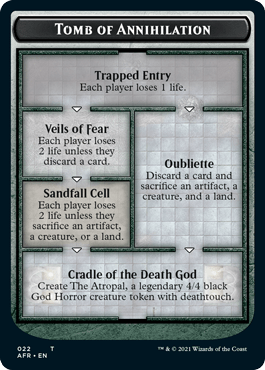

Venture Cards
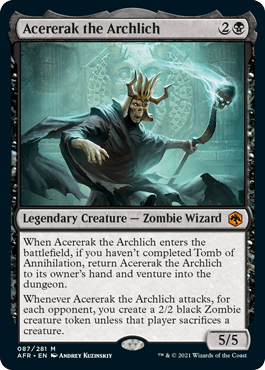
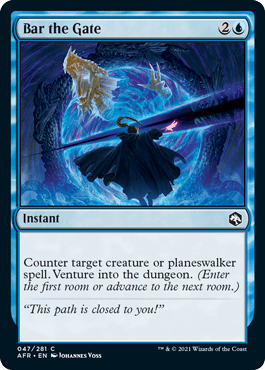

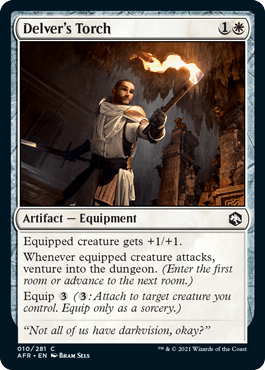
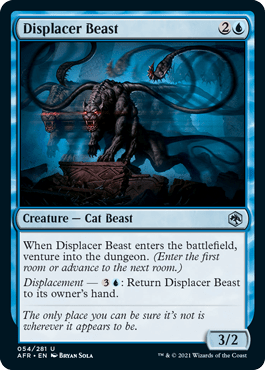
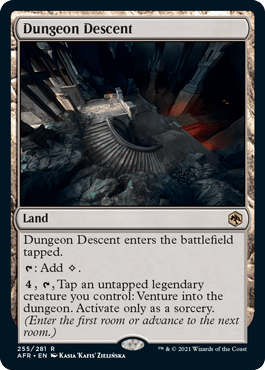
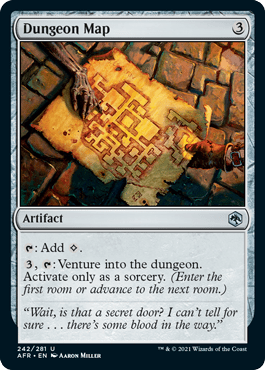


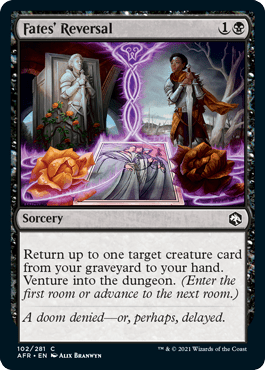

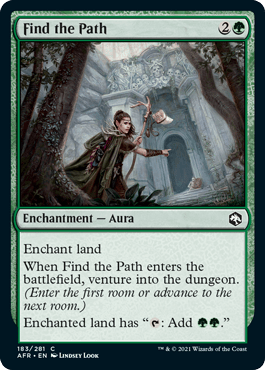
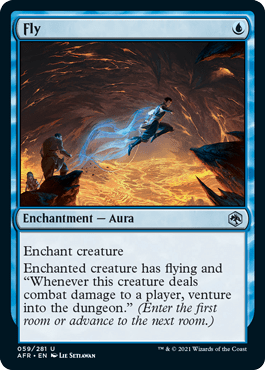

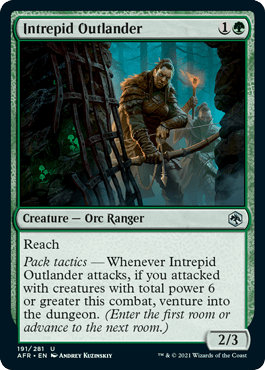

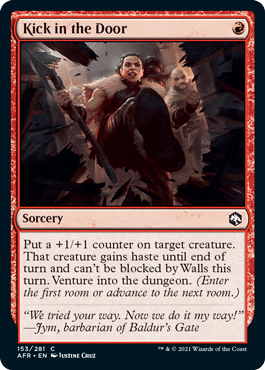
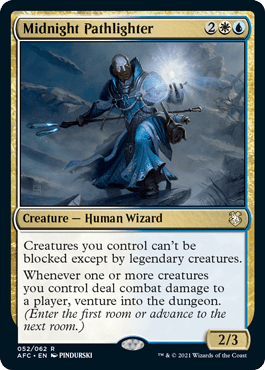

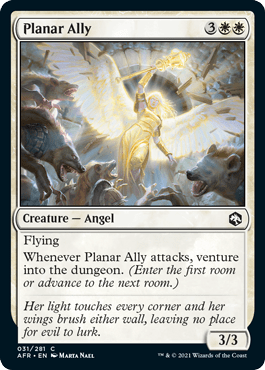
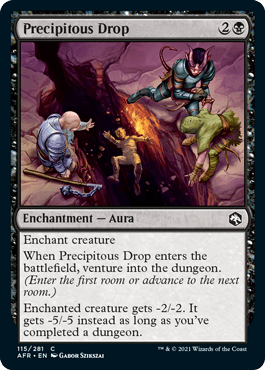
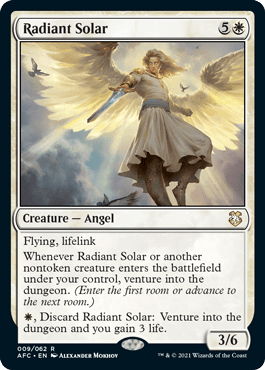
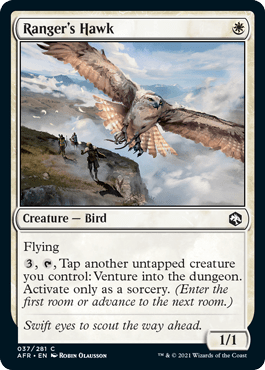
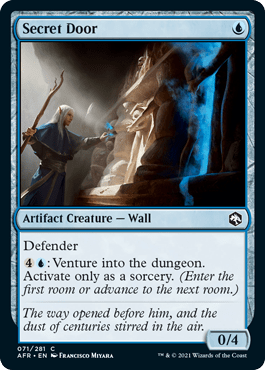

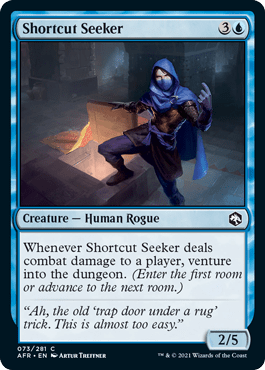
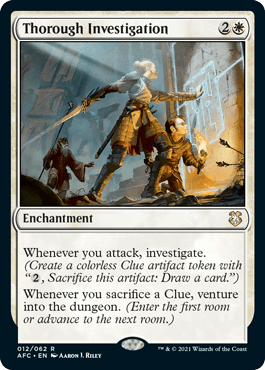


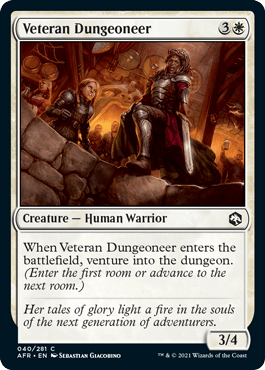
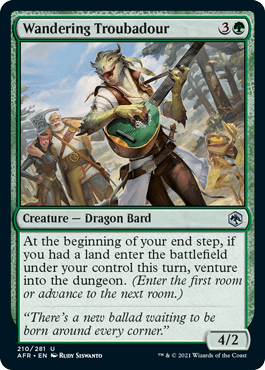

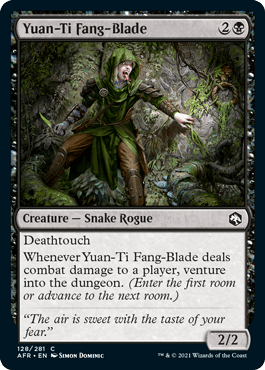
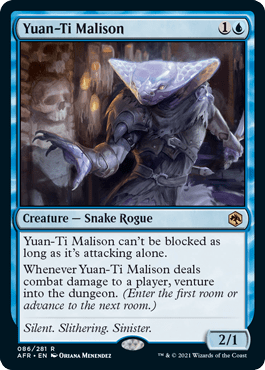

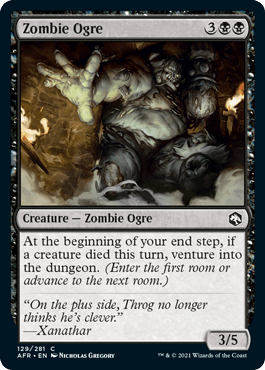
- Acererak the Archlich
- Bar the Gate
- Clattering Skeletons
- Delver's Torch
- Displacer Beast
- Dungeon Descent
- Dungeon Map
- Eccentric Apprentice
- Ellywick Tumblestrum
- Fates' Reversal
- Fifty Feet of Rope
- Find the Path
- Fly
- Immovable Rod
- Intrepid Outlander
- Keen-Eared Sentry
- Kick in the Door
- Midnight Pathlighter
- Nadaar, Selfless Paladin
- Planar Ally
- Precipitous Drop
- Radiant Solar
- Ranger's Hawk
- Secret Door
- Sefris of the Hidden Ways
- Shortcut Seeker
- Thorough Investigation
- Triumphant Adventurer
- Varis, Silverymoon Ranger
- Veteran Dungeoneer
- Wandering Troubadour
- You Find a Cursed Idol
- Yuan-Ti Fang-Blade
- Yuan-Ti Malison
- Zalto, Fire Giant Duke
- Zombie Ogre
Payoff Cards


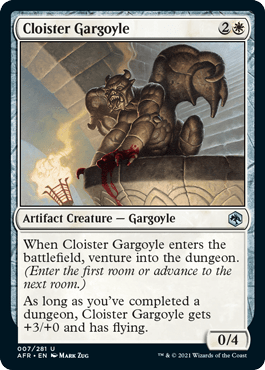


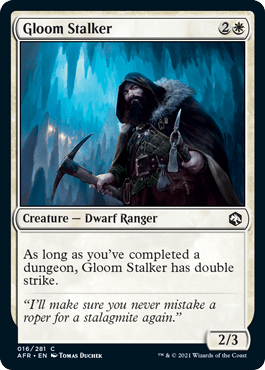


- Acererak the Archlich
- Barrowin of Clan Undurr
- Cloister Gargoyle
- Eccentric Apprentice
- Ellywick Tumblestrum
- Gloom Stalker
- Nadaar, Selfless Paladin
- Precipitous Drop
Best Venture Into the Dungeon Cards
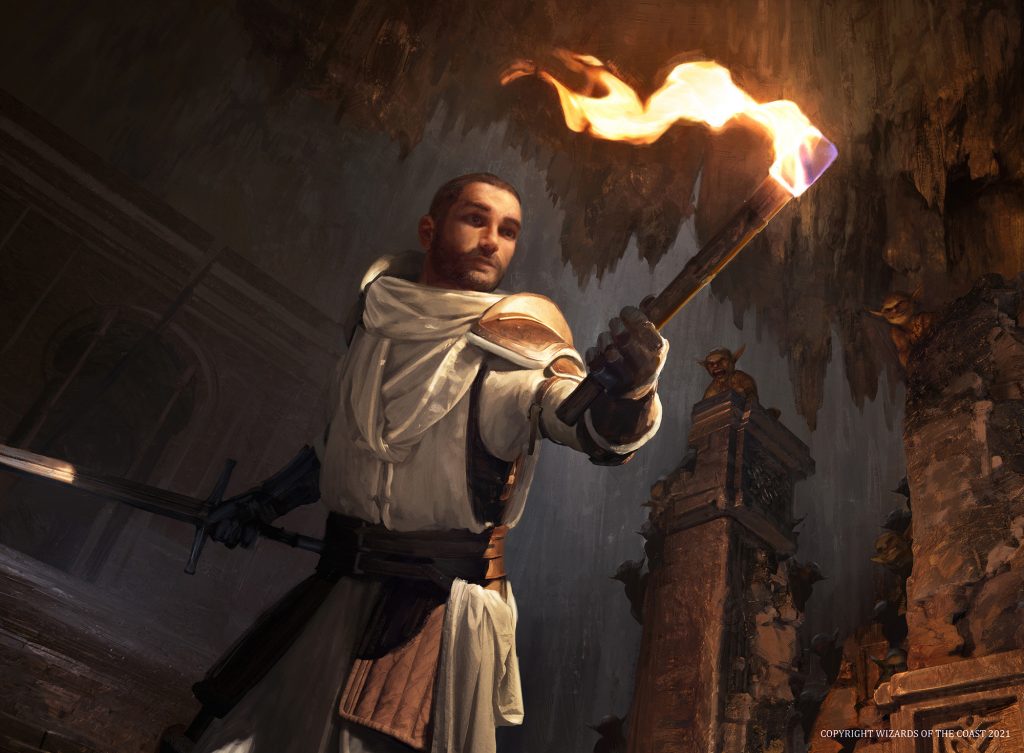
Delver's Torch | Illustration by Bram Sels
I’d rank the dungeon cards themselves, but there’s only three of them. Also Bryan already did that for me (in limited) with his AFR ultimate draft guide, so go check that out if you’re curious.
Instead, let’s take a look at venture into the dungeon cards! Even though they’ve only been printed in one set, we’ve still got quite a few options to choose from.
I’ve mentioned this before, but jank is my one true love. What I’m saying is take my advice with a grain of salt if you’re looking to figure out which venture card is the most competitively viable. These rankings are all about fun and flavor with a sprinkling of aesthetic flair. And maybe a little bit of nostalgic bias. None of that “when it enters the battlefield/attacks/deals combat damage” nonsense. I’m already bored.
Anyway. Let’s get to it!
Acererak the Archlich

Okay, I couldn’t not include this bad boy in my rankings. Acererak the Archlich is the only payoff card that requires you to have completed a specific dungeon (i.e., Tomb of Annihilation). It’s also one of the handful of venture/payoff hybrid cards, basically providing fuel towards its own value.
It’s also a fairly good card. You really need to get through that Tomb for the Archlich to be useful, but it can be a real problem for your opponents once you do. Especially if you’re playing a multiplayer format. Can you imagine piloting a Commander deck with this legendary zombie at the helm? It sounds like an absolute mess and I’d totally play that.
Sefris of the Hidden Ways
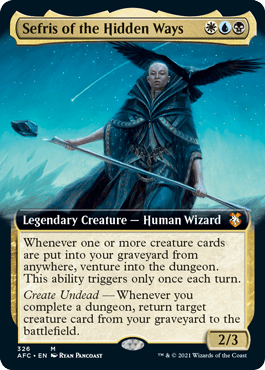
Another of the few venture/payoff hybrids, Sefris of the Hidden Ways has a bit less flavor and more practical use. It’s also another legendary creature that could absolutely rock a Commander build. It was introduced with the AFR Commander precons, after all.
Sefris really shines in a graveyard-centric build but would still do well in other archetypes. Once per turn you benefit from creatures going into your graveyard from anywhere. Had to discard? At least you’re getting something for your trouble. Your precious creature was killed in combat? Its sacrifice wasn’t in vain. Getting milled? Well, it sucks a little bit less now.
Not to mention Sefris’ “Create Undead” payoff for having completed a dungeon. Taking the lead from the D&D spell it’s named after, this ability lets you return creatures you lost to the battlefield to continue to do your bidding. This sounds like an infinite combo in the making and all I want to do is build a deck that makes it work.
Thorough Investigation

Hi, I love this. Thorough Investigation is simple, the art looks great, and the flavor makes me want to cry. Whenever you attack, you investigate and “find” a Clue. Whenever you “use a Clue” (read: spend two mana to sacrifice the token and draw a card), you venture into the dungeon. This makes me inordinately happy for absolutely no reason other than pure D&D nerd giddiness.
Immovable Rod
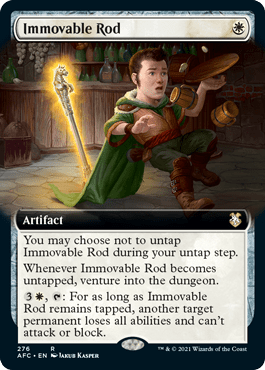
Another winner for the flavor, Immovable Rod is really fun. For its controller, at least.
Tap the Rod and then stick it right through your opponent’s most annoying creature to keep them frozen in place until you decide they’ve had enough of a time out. Sure, you only get to venture into the dungeon when you untap the artifact and let its victim go, but still. This artifact makes me want to cackle like an evil villain at the thought of slamming it through some poor unsuspecting creature to immobilize it.
The art also makes me chuckle. A little bit more innocently, mind you.
Dungeon Map / Fifty Feet of Rope


I really couldn’t decide between these two, so I just decided to feature both of them.
Dungeon Map is another incredibly simple and yet oh-so-flavorful venture card. The art is pretty while also getting a little giggle out of me, plus the card itself is useful. A very basic “pay to venture” artifact that can also be used for a bit of mana fixing if you’re in a bind. The flavor text is also great.
I like Fifty Feet of Rope probably because of that nostalgic bias I mentioned. The flavor also makes me really happy. This artifact has three abilities, each of which is flavorfully named. You can “Climb Over” a wall, “Tie Up” a particularly annoying creature, or “Rappel Down” into a dungeon. No matter what you’re up against, you’re sure to get some use out of this artifact.
Decklist: Venture Into the Dungeon in EDH
Ah, Sefris. I really do love this card. While I will definitely build my own jank nonsense with this beautiful legendary leading the charge at some point, today is not that day. We’re just gonna borrow somebody else’s labor for now.
This venture into the dungeon Commander deck features Sefris of the Hidden Ways as your commander along with the previously mentioned Dungeon Map to help you find your way. Oh, and Acererak the Archlich is there, too.
Commander (1)
Creature (35)
Acererak the Archlich
Baleful Strix
Barrowin of Clan Undurr
Burnished Hart
Champion of Wits
Cloister Gargoyle
Consecrated Sphinx
Displacer Beast
Doomed Necromancer
Elite Instructor
Fleshbag Marauder
Gray Merchant of Asphodel
Hama Pashar, Ruin Seeker
Karmic Guide
Merfolk Looter
Mulldrifter
Nadaar, Selfless Paladin
Obsessive Stitcher
Phyrexian Delver
Phyrexian Rager
Plaguecrafter
Priest of Fell Rites
Radiant Solar
Rune-Scarred Demon
Sepulchral Primordial
Sheoldred, Whispering One
Solemn Simulacrum
Stitcher's Supplier
Sun Titan
Syr Konrad, the Grim
Thassa's Oracle
Veteran Dungeoneer
Viscera Seer
Wall of Omens
Yuan-Ti Malison
Instant (4)
Cyclonic Rift
Despark
Swords to Plowshares
Utter End
Sorcery (5)
Buried Alive
Demonic Tutor
Fates' Reversal
Grim Tutor
Incarnation Technique
Enchantment (4)
Ghostly Prison
Propaganda
Rhystic Study
Rooftop Storm
Artifact (14)
Altar of Dementia
Arcane Signet
Ashnod's Altar
Azorius Signet
Dimir Signet
Dungeon Map
Fellwar Stone
Lightning Greaves
Mind Stone
Orzhov Signet
Perpetual Timepiece
Phyrexian Altar
Sol Ring
Wayfarer's Bauble
Land (37)
Arcane Sanctum
Azorius Chancery
Choked Estuary
Command Tower
Darkwater Catacombs
Dimir Aqueduct
Esper Panorama
Evolving Wilds
Exotic Orchard
Island x6
Nimbus Maze
Orzhov Basilica
Plains x6
Port Town
Prairie Stream
Sunken Hollow
Swamp x7
Terramorphic Expanse
Thriving Heath
Thriving Isle
Thriving Moor
Venture Into the Ending
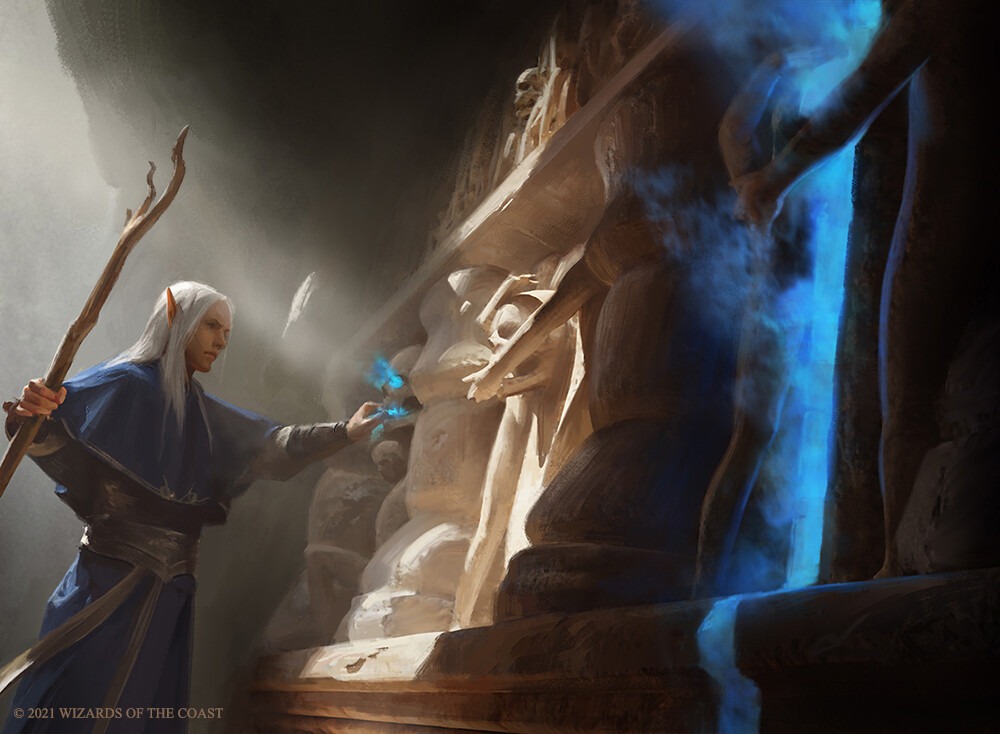
Secret Door | Illustration by Francisco Miyara
This new card type and keyword are ridiculous, but in the best way. If you ask me, at least. Which is what we’re doing right now. So.
I do recognize that I’ve got a heavy heaping of bias, through. That darn nostalgia, am I right? My aversion to competitively viable archetypes and strategies in favor of completely unhinged jank that only works one out of every hundred games probably doesn’t help either. What about you? Do you like dungeons and the new venture mechanic, or do you think it was a horrible idea that should never have been thought up?
Like I already mentioned, I highly doubt we’ll see dungeons and venture cards printed in a Standard set again in the future. They’re entirely tied to the flavor of D&D, so they wouldn’t really fit anywhere else. So this is what we’ve got for now.
With all that being said, I should probably work in some kind of natural-sounding segue for a promo at this point. Something about making sure you’ve got your hands on Arena Tutor if you play MTGA a lot. There’s also our Twitter, if you’ve got a lot of opinions you want to share somewhere other than the comments down below. I’d say that’s good enough, wouldn’t you?
Okay, I’m done now. Stay safe, stay inspired, and follow your local health guidelines. I’ll see you in the next D&D-related piece!
Follow Draftsim for awesome articles and set updates: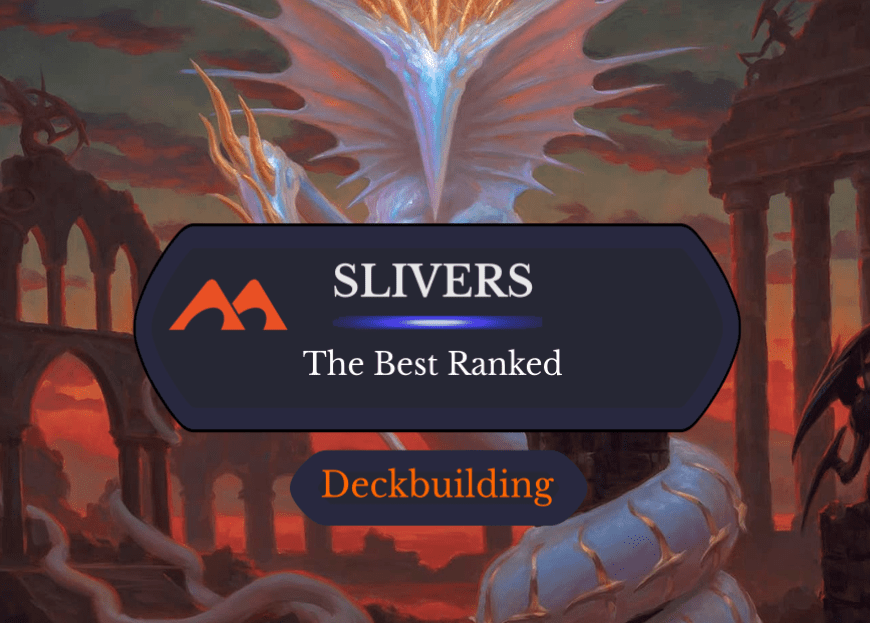

Add Comment